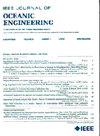Inversion of Time-Evolving Sound Speed Profiles by DREAM-zs With QPSO Proposal Distribution
IF 5.3
2区 工程技术
Q1 ENGINEERING, CIVIL
引用次数: 0
Abstract
Sound speed profile (SSP) inversion using acoustic data is an efficient approach for estimating SSPs, though it presents a nonlinear and non-Gaussian problem. To improve the spatial resolution of SSP inversion, a range-dependent environment is considered, which increases the number of parameters to be estimated. These challenges limit the performance of commonly used methods, such as the ensemble Kalman filter (EnKF) and particle filter (PF). While EnKFs can handle high-dimensional problems, they assume Gaussian probability distributions. PFs are better suited for highly nonlinear and non-Gaussian systems but are generally more computationally intensive. DiffeRential evolution adaptive Metropolis (DREAM)-zs, a Markov chain Monte Carlo method, is effective for approximating high-dimensional probability distributions, although its convergence speed decreases rapidly as the dimensionality of the parameter space increases. Quantum-behaved particle swarm optimization (QPSO), which combines principles from quantum mechanics and PSO, is a probabilistic optimization algorithm that has been proven successful in various optimization problems. To enhance the efficiency of DREAM-zs, the QPSO proposal distribution is embedded during the burn-in period, forming the DREAM-zqs method. The proposed method is used to track time-evolving SSPs in a range-dependent environment. The inversion problem is formulated in a state-space form, integrating data from the regional ocean modeling system to improve efficiency by shifting the state vector. Simulations and experimental results demonstrate that both DREAM-zs and DREAM-zqs outperform EnKF and PF, with DREAM-zqs achieving faster convergence than DREAM-zs while maintaining inversion accuracy.基于QPSO建议分布的DREAM-zs声速剖面反演
利用声学数据反演声速剖面是估计声速剖面的有效方法,但它存在非线性和非高斯问题。为了提高SSP反演的空间分辨率,考虑了距离相关环境,增加了需要估计的参数数量。这些挑战限制了常用方法的性能,如集合卡尔曼滤波(EnKF)和粒子滤波(PF)。虽然enkf可以处理高维问题,但它们假设高斯概率分布。pf更适合于高度非线性和非高斯系统,但通常计算量更大。差分进化自适应Metropolis (DREAM)-zs是一种马尔可夫链蒙特卡罗方法,可以有效地逼近高维概率分布,但其收敛速度会随着参数空间维数的增加而迅速下降。量子行为粒子群优化(QPSO)是一种结合量子力学和粒子群优化原理的概率优化算法,已被证明在各种优化问题中都是成功的。为了提高DREAM-zqs方法的效率,在老化期嵌入QPSO提案分配,形成DREAM-zqs方法。该方法用于在距离相关环境中跟踪随时间变化的ssp。该反演问题以状态空间形式表述,整合区域海洋建模系统的数据,通过转移状态向量来提高效率。仿真和实验结果表明,DREAM-zs和DREAM-zqs均优于EnKF和PF,其中DREAM-zqs在保持反演精度的同时收敛速度快于DREAM-zs。
本文章由计算机程序翻译,如有差异,请以英文原文为准。
求助全文
约1分钟内获得全文
求助全文
来源期刊

IEEE Journal of Oceanic Engineering
工程技术-工程:大洋
CiteScore
9.60
自引率
12.20%
发文量
86
审稿时长
12 months
期刊介绍:
The IEEE Journal of Oceanic Engineering (ISSN 0364-9059) is the online-only quarterly publication of the IEEE Oceanic Engineering Society (IEEE OES). The scope of the Journal is the field of interest of the IEEE OES, which encompasses all aspects of science, engineering, and technology that address research, development, and operations pertaining to all bodies of water. This includes the creation of new capabilities and technologies from concept design through prototypes, testing, and operational systems to sense, explore, understand, develop, use, and responsibly manage natural resources.
 求助内容:
求助内容: 应助结果提醒方式:
应助结果提醒方式:


